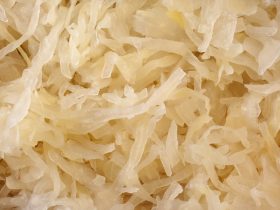Rotisserie chicken is, aptly, a whole chicken that has been roasted on a rotisserie rack. Also called spit-roasted chicken, rotisserie chicken is known for having a crispy outer skin despite a lack of breading owing to the effects of direct heat on the chicken’s plucked dermis1.
Unlike fried or otherwise treated and processed chicken, rotisserie chicken often does not incorporate additives that extend its shelf-life and is often purchased straight off the rotisserie spit with only the residual heat to keep microbial life at bay.
Much like all other forms of chicken, freezing is an excellent option in order to prevent spoilage as much as possible. Because of the lack of excess ingredients apart from an oil and spice rub added to the chicken’s surface, rotisserie chicken holds up quite well to the effects of freezing.
What is Needed to Freeze Rotisserie Chicken?
As freezing an entire rotisserie chicken whole will make it quite difficult both to store and to defrost, it is a good idea to first divide it up prior to placing it in the freezer.

In order to begin freezing your rotisserie chicken, you will require the following: aluminum foil, a cutting board, kitchen shears, a paring knife or otherwise small enough knife to remove connective tissue, as well as resealable plastic bags or freezer bags.
How to Freeze Rotisserie Chicken
First allow the chicken to cool to just above room temperature if they are fresh off the rotisserie spit. Handling the meat with your bare hands may cause burns if it is still hot. However, make sure not to forget and leave the chicken on the counter for too long, as this will attract microbial life.
Using kitchen shears and your hands, separate the chicken legs from the main torso of the chicken and set them aside. It is advisable to pull off as much meat as possible from the bones as you are doing this, since removing the chicken’s meat after it has frozen will be far more difficult.
Set aside the bones in a separate container or baking tray, as they can be used later. While you are doing this, utilize your kitchen shears once more to remove the chickens’ wings. Just as before, attempt to remove as much meat as possible from the bones, though there is very little on this particular area of the chicken.
In order to remove the meat from the chicken’s breast area, cut a thin slice beneath the breast as close as possible to the bone. Wiggle two fingers beneath this slit and tear off the chicken breast meat between your thumb and two fingers.
Use the knife to scrape off any left-over meat that may still be clinging to the bones of the chicken, particularly in the chest area of the torso.
Using your knife or simply your bare hands, shred the pulled lumps of chicken into suitably small bits of meat that will not be difficult to thaw from the freezer. Pile the processed chicken meat into resealable plastic or freezer bags.
Squeeze as much excess air out of these bags as possible and pat the chicken flat in order to facilitate defrosting and storage.
Place the flattened bags of chicken meat in the deepest part of your freezer, far from any sources of moving air such as a freezer fan or vent.
Using the aluminum foil, wrap the bones and skin (if you have elected to remove it) before also placing them in a resealable plastic bag or freezer bag. Summarily freeze these scraps as well.
What is the Ideal Temperature for Storing Rotisserie Chicken?
According to a query response article published by the United States Department of Agriculture, the ideal temperature to store cooked chicken is at a temperature significantly lower than 40°F, or the approximate temperature of most commercially available consumer refrigerators2.
It is important to keep in mind that temperatures sufficiently close enough to 40°F do not completely impede bacterial and fungal growth, instead serving to only slow them down. In order to almost entirely eliminate the colonization of your chicken by these microbial life forms, one must place the chicken in a freezing temperature storage vessel or environment.
The worst possible temperature to store rotisserie chicken, dubbed as the “danger zone” by the same author, is between the warm levels of 40°F and 140°F.
At these temperatures, pathogenic bacteria and fungi will rapidly develop colonies on and within your food, so it is best to either consume the rotisserie chicken immediately after buying or to preserve it shortly after.
What Humidity Should Rotisserie Chicken be Stored at?
Generally, cooked rotisserie chicken is immune to the effects of humid air-flow so long as it remains at the proper temperatures and is only exposed to the humid air for a short amount of time. That said, being an organic foodstuff, rotisserie chicken will nonetheless encourage the growth of microbial life in the presence of a moist environment.
However, it is best to store your chicken in a moisture-proof and air-tight container or bag, as the presence of moisture will still encourage spoilage and degradation of rotisserie chicken’s crispy texture.
Can you Refrigerate Rotisserie Chicken Instead?
Yes, refrigerating rotisserie chicken is a perfectly acceptable way to store it without compromising its taste or quality. In fact, this is the recommended method of storage by most governing bodies, especially for whole rotisserie chickens that have not been divided or otherwise cut yet.
However, keep in mind that the temperatures of most refrigerators are often dangerously close to the aforementioned “danger zone” of 40°F, meaning that the relative shelf-life of your chicken will still be quite short.
At an approximate temperature of 38°F, which is often the maximum temperature of most refrigerators, rotisserie chicken will only last an approximate three or four days. Of course, this is affected by a multitude of factors, some of which one must control for.
If the rotisserie chicken has been stored in a container that is otherwise not air-tight or has already been opened, you must wrap it in aluminum foil to prevent any of the chicken’s juices from evaporating and resulting in rubbery and dry meat.
Once wrapped in foil, place the rotisserie chicken in an air-tight resealable plastic pouch and store in the driest area of your refrigerator. Keep in mind that once reheated, the relative shelf-life of your chicken will be shortened significantly.
It is also advisable to keep the chicken away from anything that could absorb its smell such as porous plastic containers or bread products, as microscopic particles of the chicken may leak out of the bag and suffuse these objects.
What to do With Frozen Rotisserie Chicken Scraps
While the frozen rotisserie chicken meat has many uses and recipes, the bones and skin of the chicken are best used to make stocks and soups by simply placing them in boiling water with no defrosting needed.
The chicken skin may also be coated in breading and deep fried, though the pieces left over from the rotisserie chicken may not be large enough for this purpose.
References
1. Gisslen, Wayne; (et al.) (2006) Professional Cooking, for Canadian Chefs. John Wiley & Sons.
2. Unknown Author. (May 2021) “How long can you keep cooked chicken?” U.S. Department of Agriculture AskUSDA
3. Gasparro, Annie (January 4, 2018). “Rotisserie Chickens: The ’90s Gift to Supermarkets That Keeps on Giving”. The Wall Street Journal.





Hi, I'm Dom
Dom Eats was started to help other people fall in love with food. While cooking can feel intimidating, it doesn't have to be.